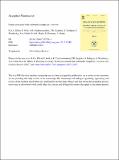Files in this item
Fenites associated with carbonatite complexes : a review
Item metadata
| dc.contributor.author | Elliott, H. A. L. | |
| dc.contributor.author | Wall, F. | |
| dc.contributor.author | Chakhmouradian, A. R. | |
| dc.contributor.author | Siegfried, P. R. | |
| dc.contributor.author | Dahlgren, S. | |
| dc.contributor.author | Weatherley, S. | |
| dc.contributor.author | Finch, A. A. | |
| dc.contributor.author | Marks, M. A. W. | |
| dc.contributor.author | Dowman, E. | |
| dc.contributor.author | Deady, E. | |
| dc.date.accessioned | 2018-12-11T13:34:58Z | |
| dc.date.available | 2018-12-11T13:34:58Z | |
| dc.date.issued | 2018-02 | |
| dc.identifier | 251798410 | |
| dc.identifier | 08ab66d4-98e4-44d8-8519-edfb0c0604c4 | |
| dc.identifier | 85038422127 | |
| dc.identifier | 000427209200003 | |
| dc.identifier.citation | Elliott , H A L , Wall , F , Chakhmouradian , A R , Siegfried , P R , Dahlgren , S , Weatherley , S , Finch , A A , Marks , M A W , Dowman , E & Deady , E 2018 , ' Fenites associated with carbonatite complexes : a review ' , Ore Geology Reviews , vol. 93 , pp. 38-59 . https://doi.org/10.1016/j.oregeorev.2017.12.003 | en |
| dc.identifier.issn | 0169-1368 | |
| dc.identifier.other | RIS: urn:3932183D90C1DC26C1EF7D42987D4B85 | |
| dc.identifier.uri | https://hdl.handle.net/10023/16661 | |
| dc.description | This research has received funding from the European Union’s Horizon 2020 research and innovation programme under grant No 689909. | en |
| dc.description.abstract | Carbonatites and alkaline-silicate rocks are the most important sources of rare earth elements (REE) and niobium (Nb), both of which are metals imperative to technological advancement and associated with high risks of supply interruption. Cooling and crystallizing carbonatitic and alkaline melts expel multiple pulses of alkali-rich aqueous fluids which metasomatize the surrounding country rocks, forming fenites during a process called fenitization. These alkalis and volatiles are original constituents of the magma that are not recorded in the carbonatite rock, and therefore fenites should not be dismissed during the description of a carbonatite system. This paper reviews the existing literature, focusing on 17 worldwide carbonatite complexes whose attributes are used to discuss the main features and processes of fenitization. Although many attempts have been made in the literature to categorize and name fenites, it is recommended that the IUGS metamorphic nomenclature be used to describe predominant mineralogy and textures. Complexing anions greatly enhance the solubility of REE and Nb in these fenitizing fluids, mobilizing them into the surrounding country rock, and precipitating REE- and Nb-enriched micro-mineral assemblages. As such, fenites have significant potential to be used as an exploration tool to find mineralized intrusions in a similar way alteration patterns are used in other ore systems, such as porphyry copper deposits. Strong trends have been identified between the presence of more complex veining textures, mineralogy and brecciation in fenites with intermediate stage Nb-enriched and later stage REE-enriched magmas. However, compiling this evidence has also highlighted large gaps in the literature relating to fenitization. These need to be addressed before fenite can be used as a comprehensive and effective exploration tool. | |
| dc.format.extent | 22 | |
| dc.format.extent | 1007219 | |
| dc.language.iso | eng | |
| dc.relation.ispartof | Ore Geology Reviews | en |
| dc.subject | Fenite | en |
| dc.subject | Carbonatite | en |
| dc.subject | Metasomatism | en |
| dc.subject | REE | en |
| dc.subject | Niobium | en |
| dc.subject | QE Geology | en |
| dc.subject.lcc | QE | en |
| dc.title | Fenites associated with carbonatite complexes : a review | en |
| dc.type | Journal item | en |
| dc.contributor.sponsor | European Commission | en |
| dc.contributor.institution | University of St Andrews. School of Earth & Environmental Sciences | en |
| dc.contributor.institution | University of St Andrews. Scottish Oceans Institute | en |
| dc.contributor.institution | University of St Andrews. St Andrews Isotope Geochemistry | en |
| dc.identifier.doi | 10.1016/j.oregeorev.2017.12.003 | |
| dc.description.status | Peer reviewed | en |
| dc.date.embargoedUntil | 2018-12-11 | |
| dc.identifier.grantnumber | 689909 | en |
This item appears in the following Collection(s)
Items in the St Andrews Research Repository are protected by copyright, with all rights reserved, unless otherwise indicated.

